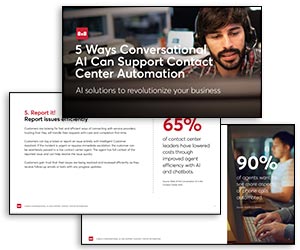It’s now widely accepted that employee experience (EX) and customer experience (CX) are intrinsically linked—employees who are happier at work tend to deliver better experiences to customers.
So, in today’s increasingly hybrid and work-from-anywhere world, how do organizations attract and keep the best customer service agents and teams?
Over the last few years, 8×8 has been part of the rapid change happening in contact centres, helping organizations to not only reimagine their technology and the way they engage and communicate with customers, but also the way agents communicate and engage across their organization.
We’ve helped many contact centre and IT leaders channel their “inner Marie Kondo” to do away with productivity clutter and ways of working that no longer bring them joy, and free up room for the long-term change that will make their employees and customers happy.
4 Tips for Change
1. Let Agents Work Productively in the Way They Want.
The forced move to remote work has shown business leaders and employees that it’s possible to work differently, even in a contact centre.
Now, many agents wish to continue working remotely for at least part of the week. In fact, 64% of employees say that they would leave their current company if they aren’t able to work remotely.
Demands for remote and hybrid work don’t mean that the traditional contact centre work environment will disappear.
Some employees and organizations will still want to have an office space available to them, either because they love the in-person vibe, teamwork, and supervision/coaching environment, or because they just aren’t comfortable with agents (at least new ones) working at home.
But no matter where work and customer and employee engagement happens, organizations will need to support workers with the best technology to help them quickly and effectively serve customers and connect with peers, subject matter experts (SMEs), and supervisors—plus improve and excel through real-time and ongoing feedback and coaching.
The same goes for managers. They need a seamless and equal way to train, supervise, mentor, and manage teams, no matter who comes into the office or is working from home that day.
2. Consolidate to Create a Simpler Technology Landscape.
The contact centre technology stack has always been complex and time-consuming to manage, with organizations having to add new products or integrate different apps to get new functionality.
Now we’re seeing companies look again at what they’ve got and take action to simplify their stack. There are lots of reasons why doing this is beneficial.
For IT admins, it’s a lot easier to manage and maintain. Fewer vendors, or a platform approach, means fewer contacts and contracts to manage, and fewer entry points to monitor for security. Plus, data and analytics come from a single source—a huge win where metrics matter.
There’s also a positive impact on users. They will need less training and won’t have to switch between applications as often.
And they will be able to more quickly and confidently serve customers as the ability to rapidly collaborate with the right experts across the organization dramatically speeds up issue and first contact resolution. It all contributes to people achieving more and having greater job satisfaction.
3. Deliver Tools That Support Proactive and Productive Customer Engagement.
Consumer expectations and demands are increasingly digital, and goodwill is running out for organizations that can’t respond to this. Gartner recently noted that proactive customer engagement will become the number one priority for customer service leaders.
In addition, agent expectations and demands regarding technology are increasing. Younger employees especially expect something that’s easy to use and understand, and that is similar to the tech they use as consumers.
4. Embrace Company-Wide Ownership of Customer Service.
Until recently, it was widely believed that customer service was the responsibility of the contact centre. But more and more, other parts of the organization are contributing to customer support and customer experience.
In a recent survey of CX leaders, 40% said that customer service will be the role of every department by 2030.
We’re already seeing this in retail, for example, where shop floor staff are taking on contact centre-type tasks, and in lines of business where specialist teams, sales, and SMEs are increasingly talking directly to customers.
Using analytics and the right solution to optimize them (for example 8×8’s Conversation IQ, which uses automatic transcript scanning to analyze customer needs or identify unhappy customers), insights can be shared across the platform and organization to improve the overall customer experience.
It’s clear that customer service will continue to shape-shift as buying patterns and customer service channel preferences change.
As the way that customers engage with businesses changes, so does how we serve them. This requires a consistent cloud platform approach, but also an open one that will support integrations, agility, and the continuing evolution of CX and EX.
561509971
This blog post has been re-published by kind permission of 8x8 – View the Original Article
For more information about 8x8 - visit the 8x8 Website
Call Centre Helper is not responsible for the content of these guest blog posts. The opinions expressed in this article are those of the author, and do not necessarily reflect those of Call Centre Helper.
Author: 8x8
Published On: 24th Oct 2022
Read more about - Guest Blogs, 8x8






 8x8 is transforming the future of business communications as a leading Software-as-a-Service provider of voice, video, chat, contact centre, and enterprise-class API solutions, powered by one global cloud communications platform.
8x8 is transforming the future of business communications as a leading Software-as-a-Service provider of voice, video, chat, contact centre, and enterprise-class API solutions, powered by one global cloud communications platform. 




























